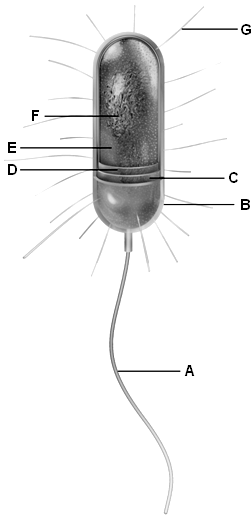A) lysosome
B) peroxisome
C) Golgi body
D) vacuole
E) rough ER
G) B) and D)
Correct Answer

verified
Correct Answer
verified
Matching
Match each cell structure represented with the appropriate description.
Correct Answer
Multiple Choice
The phospholipids of plasma membranes contain _____.
A) a hydrophobic head and a hydrophilic tail
B) two hydrophobic heads and a hydrophilic tail
C) a hydrophobic head and two hydrophobic tails
D) a hydrophilic head and two hydrophobic tails
E) a hydrophilic head and two hydrophilic tails
G) B) and E)
Correct Answer

verified
Correct Answer
verified
Multiple Choice
Since viruses are typically 20-200 nm in diameter, the ____ microscope is best for viewing them.
A) light
B) electron
C) fluorescent
D) polarizing
E) contrasting
G) B) and E)
Correct Answer

verified
Correct Answer
verified
Multiple Choice
Which organelle is correctly matched with its function?
A) vacuoles: production of ATP from carbohydrates
B) rough ER: synthesis of plasma membrane proteins
C) Golgi bodies: synthesis of membrane phospholipids
D) mitochondria: capture of light for photosynthesis
E) smooth ER: digestion of invading bacteria
G) A) and C)
Correct Answer

verified
Correct Answer
verified
Multiple Choice
A basement membrane ____.
A) is a cell membrane
B) is a specialized lipid bilayer
C) forms on the surface of plant cells
D) supports and organizes animal tissues
E) is a sheet of nonfibrous material
G) B) and E)
Correct Answer

verified
Correct Answer
verified
Matching
Examine the following figure. Match each letter of the figure with the appropriate cell structure. 
Correct Answer
Multiple Choice
A hypothetical "microbullet" shot through a phospholipid bilayer will pass the bilayer components in which order?
A) tail → tail → head → head
B) head → tail → tail → head
C) head → tail → head → tail
D) head → head → tail → tail
E) tail → head → tail → head
G) C) and D)
Correct Answer

verified
Correct Answer
verified
Multiple Choice
The plasma membrane is composed mostly of ____.
A) phospholipids
B) cholesterol
C) triglycerides
D) steroids
E) sphingolipids
G) D) and E)
Correct Answer

verified
Correct Answer
verified
Multiple Choice
Ribosomes are ____.
A) membrane-enclosed organelles
B) attached to the smooth endoplasmic reticulum
C) involved in polypeptide transport
D) required for DNA synthesis
E) involved in polypeptide synthesis
G) A) and E)
Correct Answer

verified
Correct Answer
verified
Multiple Choice
Cell shape is reinforced by ____.
A) phospholipids
B) DNA
C) cytoskeletal filaments
D) transport proteins
E) ribosomes
G) A) and E)
Correct Answer

verified
Correct Answer
verified
Multiple Choice
If a microscopic pin was stuck into the center of a bacterium, what would be the order of the structures encountered from the outside in?
A) capsule; cell wall; plasma membrane; cytoplasm
B) cell wall; capsule; plasma membrane; cytoplasm
C) plasma membrane; cell wall; capsule; cytoplasm
D) cell wall; plasma membrane; capsule; cytoplasm
E) capsule; plasma membrane; cell wall; cytoplasm
G) A) and E)
Correct Answer

verified
Correct Answer
verified
Multiple Choice
The ____ is responsible for making the lipids that form the cell's membranes.
A) rough ER
B) smooth ER
C) Golgi body
D) peroxisome
E) mitochondria
G) D) and E)
Correct Answer

verified
Correct Answer
verified
Multiple Choice
What accounts for the fluidity that defines the fluid mosaic model of a typical plasma membrane?
A) The proteins, being large, cause the membrane to jiggle around.
B) The phospholipids collectively form a jellylike substance similar to the cytoplasm.
C) The phospholipids are not bonded to each other and thus are freer to move around.
D) Water molecules infiltrate the bilayer causing it to become more watery and thus more fluid.
E) The phospholipids in a typical plasma membrane form covalent bonds, which are elastic and allow the membrane to stretch.
G) A) and B)
Correct Answer

verified
Correct Answer
verified
Multiple Choice
Biofilms found in nature ____.
A) contain only bacteria
B) are composed of multicellular organisms
C) are most often found on liquid surfaces
D) are communities of unicellular organisms
E) contain only closely related organisms
G) A) and C)
Correct Answer

verified
Correct Answer
verified
Multiple Choice
The endoplasmic reticulum is an extension of ____.
A) the cytoskeleton
B) flagella
C) cilia
D) the nuclear envelope
E) the plasma membrane
G) B) and D)
Correct Answer

verified
Correct Answer
verified
Multiple Choice
Meat, fruits, and vegetables could be contaminated with E. coli strains toxic to humans when they come in contact with animal ____. I. feces II. urine III. blood
A) I only
B) I and II
C) II and III
D) I and III
E) I, II, and III
G) A) and E)
Correct Answer

verified
Correct Answer
verified
Multiple Choice
Vesicles from the Golgi body that will become lysosomes contain enzymes for ____.
A) aerobic respiration
B) photosynthesis
C) breaking down cellular debris
D) protein synthesis
E) digesting amino acids and fatty acids
G) D) and E)
Correct Answer

verified
Correct Answer
verified
Multiple Choice
A molecular analysis of plasma or nuclear membranes would reveal the presence of _____.
A) cellulose and chitin
B) suberin and cutin
C) phospholipids and proteins
D) microtubules and microfilaments
E) phospholipids and nucleic acids
G) D) and E)
Correct Answer

verified
Correct Answer
verified
Multiple Choice
Which statement describes bacteria?
A) Most bacteria are harmful.
B) Bacteria only inhabit surfaces.
C) Bacteria outnumber human cells in our bodies.
D) Bacteria are restricted in their distribution to certain ecosystems.
E) Bacteria are the most common organisms in the domain Eukarya.
G) A) and C)
Correct Answer

verified
Correct Answer
verified
Showing 21 - 40 of 74
Related Exams